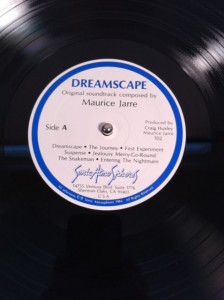I discovered this clip posted by Blake Hennequin on YouTube. Turnaround: A Vinyl Documentary seems to be a short vinyl-centric film rather than a feature-length documentary, but no matter–what grabbed my eye was the fantastic opening montage of a variety of vinyl records of all shapes and sizes spinning on a wide range of turntables. Gorgeous stuff. Sadly, it’s difficult to track down anything more about the film, but here’s the seven-minute long clip. Feast your eyes on those records!
Tag Archives: records
Vinyl Blogs To Love: Vinyl Record Architect
 I tend to share about fellow vinyl bloggers based on my discovery of them–the first time I find ’em and get excited about reading them, I wind up passing them along here. Paul Rosenblatt’s excellent Vinyl Record Architect is no exception. I found this blog recently and got hooked right away thanks to his post detailing a visit to Pittsburgh’s Sound Cat Records.
I tend to share about fellow vinyl bloggers based on my discovery of them–the first time I find ’em and get excited about reading them, I wind up passing them along here. Paul Rosenblatt’s excellent Vinyl Record Architect is no exception. I found this blog recently and got hooked right away thanks to his post detailing a visit to Pittsburgh’s Sound Cat Records.
It reads a lot like our own Vinyl Road Rage posts, so I was naturally happy to see someone else detailing their record shop experiences, turning the rest of us on to new-to-use places to dig through the crates.
Rosenblatt’s bio on the site reads (unintentionally) a bit like a superhero About Us page–by day, he works as an architect as the head of Springboard Design. By night he’s a vinyl blogger and definitely in love with LPs and has plenty of good intel on Philly record shops and more.
Without gushing too terribly much, I highly recommend this vinyl blog–my only gripe is that I wish there was 2000% more of it. But it’s a damn fine read, whatever the length. He seems to post a bit more frequently than Dust and Grooves, but the posts are every bit as enjoyable. One to be bookmarked, for sure.
–Joe Wallace
Turntabling Reader Questions: How Do I Grade A Used Vinyl Record?
 Turntabling gets plenty of questions about vinyl, record collecting, album titles, etc. A lot of them come when the Turntabling booth is set up at shows like Horrorhound Weekend, Cinema Wasteland, Capricon, etc. but from time to time the questions do come in by e-mail or the comments section.
Turntabling gets plenty of questions about vinyl, record collecting, album titles, etc. A lot of them come when the Turntabling booth is set up at shows like Horrorhound Weekend, Cinema Wasteland, Capricon, etc. but from time to time the questions do come in by e-mail or the comments section.
One recent question had to do with grading vinyl records. How does a newcomer to record buying and selling accurately judge the quality of a record or get a good idea of the record album’s condition as described for sale on eBay, Discogs.com or Etsy?
An Introduction To Vinyl Grading
Many record sellers use the Goldmine standard or a variation of it. Basically, Goldmine standard grading runs from Good, Very Good, and variations of VG (Very Good Plus, VG++. etc.) to Near Mint, and Mint.
Grading applies separately to album covers and the vinyl records themselves–or at least it SHOULD.
Some use an alternative system of vinyl grades like “Clean” or “Exceptionally Clean”, but some of us in the vinyl collecting and selling community distrust such descriptions because they seem to be trying to hide something.That is obviously not true in every case but for some buyers it can be a red flag.
No matter–nobody forces you to buy vinyl without inspecting it and if you’re uncomfortable with a seller’s grading system, don’t buy unless you can inspect.
Mint condition records are generally those that have never been played or seem to have never been played. A conservative grader is your friend when it comes to buying records on line, and those who claim that a vinyl record is “Mint” are usually saying it’s never been played or played once.
That does NOT mean “still sealed” but obviously sealed records are in Mint condition unless there’s been poor storage and handling.
Rather than take the time to run down the entire list of possible record conditions and hope it’s been communicated properly (we WILL do that in another post, this is a GETTING STARTED guide) there is an easier way for you to begin learning what record grading is all about.
Find a record store that sells used vinyl and lists the condition of that vinyl on a label on the sleeve. Study what that record store considers to be a “Good” condition record. Records in Good condition are often anything but.
Now compare what that store considers to be in Near Mint condition. See the vast difference? Once you get an idea of what the extremes are–again, according to THAT STORE–have a look at the Very Good condition records and compare them with the Near Mints.
You may begin to notice less difference in some cases between Very Good or Very Good Plus and Near Mint.
That’s because every record grader, like it or not, has their own pet peeves. Some will decide one vinyl LP that is considered Near Mint by one grader is actually Very Good Plus album because of a certain type of scratch, nick, or other type of wear.
Conservative record album graders–the fussy ones, the people who don’t give away Near Mint status very easily–are your best friend when it’s time to buy online. Near Mint records are not always pristine and perfect, but Very Good records aren’t always scratchy or obviously worn, either.
What you’re after is a better idea of the range of tolerances in your own purchasing and/or selling habits.
What does Very Good or VG+ mean to you the buyer when you play the record? Do you care if the album is NM or NM-?
Some do and some do not. It’s all down to personal preference. In another blog post (several, I expect) we’ll tackle the more in-depth complexities in record grading. In the meantime, the more records you study yourself, the better you’ll get at determining condition and whether you’re personally comfortable buying an album in the specified condition.
Don’t forget that this is NOT an exact science and your preferences have much to do with how you interpret the grading system. I’ll be writing much more on this subject in the weeks to come.
–Joe Wallace
Talking Vinyl Mastering With George Peckham
Nico of No U Turn Records interviewed George Peckham about mastering vinyl records and more in this excellent Youtube clip. The best part of this clip aside from all the insights is Peckham’s basic philosophy: “Make it louder!” Totally awesome.